Register by Jan 13 to save on passes and connect with marketers from Uber, Bose and more

As Substack invests in video content, the platform’s smaller creators stand to gain the most subscribers and advertisers by embracing the medium.
Over the past year, Substack has considerably expanded its video tools for both creators and audience members. In January, Substack launched live video as a tool for all users. In early March, the company enabled video posts for mobile users for the first time; two weeks later, the platform rolled out its first TikTok-style video feed.
Six months into 2025, however, Substack’s video push has resulted in mixed results for creators on the platform, with the impact of video on individual Substackers’ subscriber growth varying widely depending on the size of the creator’s following, according to an analysis of over 58,000 active Substack accounts by Subalytics, an influencer marketing platform with data on Bluesky, Substack and Medium creators. (Substack has not publicly disclosed how many accounts have been active on the platform in 2025, but the company’s founders shared in a December blog post that “more than 50,000 publishers” had made money on Substack in 2024.)
Subalytics analyzed subscriber growth by comparing Substack accounts where over 50 percent of posts contained video to those using video in less than 25 percent of their posts. Among Substack creators with between 500 and 5,000 subscribers, video-heavy accounts grew by 47 percent since the start of the year, compared to only 36 percent for those relying on text. Among Substack creators with 50,000 or more subscribers, video-heavy accounts had grown by 11 percent, compared to 19 percent for text-focused accounts.
Unlike larger, “legacy” Substack accounts, smaller Substack accounts are more likely to be built around video from day one, according to Subalytics CEO Timofey Pletz. “The new, smaller accounts want to stand out on a platform that they’re trying to conquer, and they’re trying new things — and a new audience, or the same audience that is looking for something fresh, is starting to pick up on that,” Pletz said.
One such smaller Substack creator who has found success by focusing on video is Andrew Keen, whose Substack Keen On America has 3,100 subscribers — and who includes videos in 100 percent of his posts in 2025, according to Subalytics’ analysis. Keen, who also shares his podcast on Apple and YouTube, told Digiday that he had experienced a “very effective” uptick in both free and paid subscribers since introducing video to his Substack, although he declined to share specific numbers. Keen said that he does not currently have any brand partnerships tied to his Substack content.
Although Substack doesn’t view itself as a competitor of other video platforms, creators say it has unique benefits. Keen said that one of Substack’s biggest advantages over other video platforms is the depth of audience data it offers. Unlike YouTube, which only lets creators see the names of subscribers who’ve made their preferences public, Substack gives all creators access to a full list of their subscribers — including detailed metrics, such as open rates and subscription history, as well as demographic insights.
“Podcasting is a black hole,” Keen said. “Who knows what the real numbers are.”
Total subscriber count is a key metric for brands looking to reach a Substacker’s audience, per Pletz, who said that this metric provides a better sense of a creator’s overall reach than their paid subscriber count. Although influencer marketing activity on Substack remains relatively minimal compared to influencer marketing on other platforms, top creators that have used video on Substack, such as Jomboy Media, view the platform as a potential growth area for their sponsorship business.
“We work with a fantastic range of brand partners on our YouTube shows, and if the opportunity is right we’d certainly be open to pairing the right sponsor with our core community on Substack, especially if they can elevate the special offering we’re trying to build there,” said Jomboy Media CEO Courtney Hirsch. Jomboy Media views Substack as “a place for our core community members,” per Hirsch, who said that over 90 percent of the company’s Substack content is exclusive to the platform, including videos such as longer, unedited cuts of shows and trial runs of new content ideas.
Although top-tier Substack accounts that prioritize video are growing at a slower rate than text-heavy accounts, they are still growing, and some larger Substack creators view video — and particularly live video — as a key tool to help build their following. Glenn Kirschner, whose Substack boasts over 85,000 followers, said that he believes Substack is an additive opportunity because the fans who tune into his regular live broadcasts on the platform represent a different group than the million-plus subscribers who consume long-form video on his YouTube account.
“I think there’s minimal overlap,” said Kirschner, who co-hosts a podcast, the Legal Breakdown, with fellow political creator Brian Tyler Cohen in addition to his individual presence on YouTube and Substack. “With Brian, I know the Legal Breakdown skews very young; my YouTube skews older. Substack, I would bet, is somewhere in between.”
The video opportunity on Substack — particularly for smaller creators whose subscription growth has been boosted by the format — could help the platform maintain its lead with newsletter creators during a time in which some have grown increasingly wary of Substack due to both its perceived ideological shift to the right and its monetization model, which some say favors creators less than that of other newsletter services. To creators with a significant video focus, Substack’s more advanced video feed and video tools are a selling point to stay the course on the platform.
“I had been podcasting before on other platforms and always with a video and an audio feed, largely because of YouTube’s reach,” said Substack writer Michael Conniff. “When Substack came along, the user interface made it easy to do video with or without newsletter articles, so it became low-hanging fruit for me.”
More in Media

Future starts to sharpen its AI search visibility playbook
Future is boosting AI search citations and mentions with a tool called Future Optic, and offering the product to branded content clients.

Digiday’s extensive guide to what’s in and out for creators in 2026
With AI-generated content flooding social media platforms, embracing the messiness and imperfection of being human will help creators stand out in the spreading sea of slapdash slop.

Media Briefing: Here’s what media execs are prioritizing in 2026
Media executives enter 2026 weathered by disruption, but refocused on AI revenue, brand strength and video and creator opportunities.





